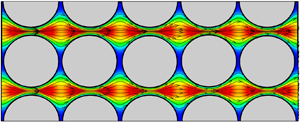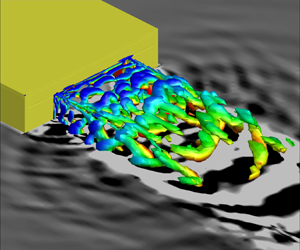Refine listing
Actions for selected content:
1418034 results in Open Access
UHY volume 50 issue 4 Cover and Back matter
-
- Journal:
- Urban History / Volume 50 / Issue 4 / November 2023
- Published online by Cambridge University Press:
- 12 January 2024, pp. b1-b3
-
- Article
-
- You have access
- Export citation
Empires, Languages, and Scripts in the Perso-Indian World
-
- Journal:
- Comparative Studies in Society and History / Volume 66 / Issue 2 / April 2024
- Published online by Cambridge University Press:
- 11 January 2024, pp. 443-469
-
- Article
-
- You have access
- Open access
- HTML
- Export citation
Pore-scale modelling of particle transport in a porous bed
-
- Journal:
- Journal of Fluid Mechanics / Volume 979 / 25 January 2024
- Published online by Cambridge University Press:
- 11 January 2024, A9
-
- Article
- Export citation
Fixed-flux Rayleigh–Bénard convection in doubly periodic domains: generation of large-scale shear
-
- Journal:
- Journal of Fluid Mechanics / Volume 979 / 25 January 2024
- Published online by Cambridge University Press:
- 11 January 2024, A19
-
- Article
- Export citation
Noise mitigation in rectangular jets through plasma actuator-based shear layer control
-
- Journal:
- Journal of Fluid Mechanics / Volume 979 / 25 January 2024
- Published online by Cambridge University Press:
- 11 January 2024, A16
-
- Article
-
- You have access
- Open access
- HTML
- Export citation
The Struggle for the People’s King: How Politics Transforms the Memory of the Civil Rights Movement. By Hajar Yazdiha. Princeton, NJ: Princeton University Press, 2023. 286p. $95.00 cloth, $29.95 paper. - After Black Lives Matter: Policing and Anti-Capitalist Struggle. By Cedric Johnson. New York: Verso Books, 2023. 416p. $34.95 cloth.
-
- Journal:
- Perspectives on Politics / Volume 22 / Issue 3 / September 2024
- Published online by Cambridge University Press:
- 11 January 2024, pp. 881-883
- Print publication:
- September 2024
-
- Article
- Export citation
Bragg scattering of nonlinear surface waves by sinusoidal sandbars
-
- Journal:
- Journal of Fluid Mechanics / Volume 979 / 25 January 2024
- Published online by Cambridge University Press:
- 11 January 2024, A13
-
- Article
- Export citation
Divisive or Descriptive?: How Americans Understand Critical Race Theory
-
- Journal:
- Journal of Race, Ethnicity and Politics / Volume 9 / Issue 1 / March 2024
- Published online by Cambridge University Press:
- 11 January 2024, pp. 157-181
-
- Article
-
- You have access
- Open access
- HTML
- Export citation
Perspectives of the Court of the Astana International Financial Centre: Potential to Transform the Central Asian Legal Landscape
-
- Journal:
- Asian Journal of Comparative Law / Volume 19 / Issue 1 / April 2024
- Published online by Cambridge University Press:
- 11 January 2024, pp. 160-179
-
- Article
- Export citation
Walking the Gendered Tightrope: Theresa May and Nancy Pelosi as Legislative Leaders. By Melissa Haussman and Karen M. Kedrowski. Ann Arbor: University of Michigan Press, 2023. 288 pp. $80.00 (cloth), ISBN: 9780472076345; $39.95 (paper), ISBN: 9780472056347.
-
- Journal:
- Politics & Gender / Volume 20 / Issue 3 / September 2024
- Published online by Cambridge University Press:
- 11 January 2024, pp. 782-784
-
- Article
- Export citation
Controlled mean dynamics of red blood cells by two orthogonal ultrasonic standing waves
-
- Journal:
- Journal of Fluid Mechanics / Volume 979 / 25 January 2024
- Published online by Cambridge University Press:
- 11 January 2024, A11
-
- Article
- Export citation
Psychological Biases and Democratic Anxiety: A Comment on Little and Meng (2023)
-
- Journal:
- PS: Political Science & Politics / Volume 57 / Issue 2 / April 2024
- Published online by Cambridge University Press:
- 11 January 2024, pp. 194-197
- Print publication:
- April 2024
-
- Article
-
- You have access
- Open access
- HTML
- Export citation
Disaster Preparedness in a Resettled Refugee Community: Qualitative Findings
-
- Journal:
- Disaster Medicine and Public Health Preparedness / Volume 18 / 2024
- Published online by Cambridge University Press:
- 11 January 2024, e2
-
- Article
- Export citation
In This Issue
-
- Journal:
- Journal of Developmental Origins of Health and Disease / Volume 14 / Issue 5 / October 2023
- Published online by Cambridge University Press:
- 11 January 2024, pp. 557-558
-
- Article
-
- You have access
- HTML
- Export citation
A machine that still doesn't quite understand us: Putting ChatGPT to the test
-
- Journal:
- English Today / Volume 40 / Issue 3 / September 2024
- Published online by Cambridge University Press:
- 11 January 2024, pp. 167-175
- Print publication:
- September 2024
-
- Article
-
- You have access
- HTML
- Export citation
What the Schwartzes Told Me about Allomorph Priority
-
- Journal:
- Journal of Germanic Linguistics / Volume 36 / Issue 1 / March 2024
- Published online by Cambridge University Press:
- 11 January 2024, pp. 32-46
-
- Article
- Export citation
Quasilinear duality and inversion in Banach spaces
-
- Journal:
- Proceedings of the Royal Society of Edinburgh. Section A: Mathematics / Volume 155 / Issue 4 / August 2025
- Published online by Cambridge University Press:
- 11 January 2024, pp. 1223-1239
- Print publication:
- August 2025
-
- Article
-
- You have access
- Open access
- HTML
- Export citation
Reframing interventions for optimal child nutrition and childhood obesity: the importance of considering psychological factors
- Part of
-
- Journal:
- Proceedings of the Nutrition Society / Volume 84 / Issue 1 / February 2025
- Published online by Cambridge University Press:
- 11 January 2024, pp. 53-64
-
- Article
-
- You have access
- Open access
- HTML
- Export citation
Minabere Ibelema. Cultural Chauvinism: Intercultural Communication and the Politics of Superiority. New York: Routledge, 2021. xiv + 140 pp. Notes. References. Index. $24.95. Paper. ISBN: 9780367710033.
-
- Journal:
- African Studies Review / Volume 67 / Issue 2 / June 2024
- Published online by Cambridge University Press:
- 11 January 2024, pp. 480-481
-
- Article
-
- You have access
- HTML
- Export citation



















